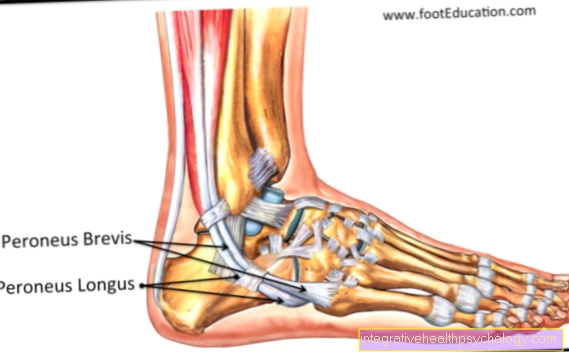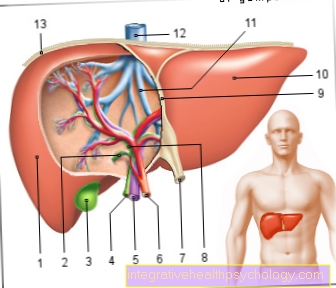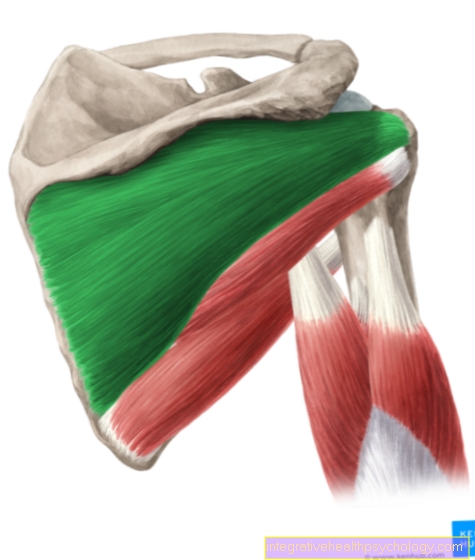Metastasis in breast cancer
introduction
Metastases denote daughter tumors of a primary tumor, which can be found in practically any tissue in the body, even very far away from the actual tumor.
As with all types of cancer, a distinction is made in principle with breast cancer as well, through which the original tumor can spread.
On the one hand there is lymphogenic metastasis, which means that it spreads through the body's lymphatic system. This form is particularly pronounced in breast cancer.
In addition, there is hematogenous metastasis, i.e. the spread of tumor cells via the blood, which leads to what are known as distant metastases.

What influence do metastases have on life expectancy?
Life expectancy with breast cancer is heavily dependent on many factors and thus also on the metastasis. In general, it can be said that every cancer has a very different course and that even the most advanced stages must be viewed and assessed individually.
Statistically, life expectancy decreases at a higher stage of the disease, also due to the presence of metastases. Cancer therapy initially includes an exact diagnosis, the so-called “staging”, through which the size of the tumor in the breast, as well as metastases in the surrounding lymph nodes or in distant organs are detected. The interaction of these criteria results in a tumor stage that has a different prognosis.
Many breast cancers can be cured today, and around 9 out of 10 patients still survive five years later. With the presence of metastases, this number can statistically drop to 1 in 4 patients in five years. It is also relevant whether the metastasis is in the neighboring lymph node or in the brain, bones or lungs. The latter have a particularly negative impact on life expectancy.
For general cancer treatment, in addition to removing the tumor in the breast, the lymph nodes in the armpit can also be removed in the event of a tumor. In many cases, these are the first to be affected by metastases. Chemotherapy too and the radiation is primarily directed against small, undiscovered metastases. The chemotherapy works throughout the body, whereas the radiation only affects the organ area that is irradiated. The radiation is usually aimed at the primary tumor or individual organ metastases.
Read more about: End-stage breast cancer
What influence does a metastasis have on the chance of recovery?
The chance of a cure for breast cancer also decreases statistically with the presence of metastases. Nowadays, however, many people with breast cancer can be cured. This is mainly thanks to modern chemotherapy, surgery and radiation. The therapy of advanced breast cancer consists of these three pillars.
If possible, an operation is carried out today while conserving the breast. The diagnosis and treatment of the nearby lymph nodes has also improved significantly, so that it is now often no longer necessary to remove all lymph nodes with sometimes severe side effects.
In cancer treatment, it can never be ruled out that there are not small, undiscovered metastases in the cancer drainage area that can grow weeks to months after the operation. For this reason, even in the absence of metastases, chemotherapy is often used to attack undetected cancer cells throughout the body.
Basically, the chance of recovery decreases if there are metastases. The therapy and the associated prognosis often change, particularly in the case of metastases in distant organs. Metastases in the bones, brain, lungs and liver are the most common regions of metastasis in breast cancer. If the body is infected with metastases, healing is no longer realistic and can no longer be sought by doctors. In the case of metastases in many different organs, it must be considered with the patient whether comprehensive therapy with the intention of healing is useful and should still be carried out.
Read more about this under: Chances of a cure in breast cancer
Hematogenous metastases
For hematogenous metastasis, there are certain organs for each tumor that are preferentially affected. It has not yet been possible to finally clarify what this is due to.
The organs that are typically affected by distant metastases in breast cancer (breast cancer) are:
- bone
- lung
- liver
and - brain
seldom too - heart
- kidney
or - spleen
As soon as distant metastases are diagnosed, the chances of survival for those with the disease are very slim.
Lymphogenic metastases
In lymphogenic metastasis, metastases are mainly formed in lymph nodes. Breast cancer metastases are often found in the axillary lymph nodes (the lymph nodes in the armpit), and other lymph nodes in the vicinity of the breast are more rarely affected.
Lymphogenic metastasis is the most common metastasis in breast cancer. The lymph from the breast is channeled into large lymph node regions in the armpit and around the collarbone. It initially flows into a first lymph node and from there is distributed to the surrounding lymphatic drainage pathways before the lymph is distributed into the body's circulation. In the lymphatic fluid, malignant cells can drain into the first lymph nodes even in the early stages of cancer. This first node is also known as the "sentinel or guardian lymph node".
This lymph node is recognized and removed as part of the diagnosis. Once removed, the sentinel lymph node is examined for malignant cells. If this is affected by cancer cells, the cancer has probably already spread further, which is why all lymph nodes in this area must be temporarily removed. If the sentinel lymph node is not involved, the prognosis improves and metastasis to the lymph nodes cannot be assumed. Removing all armpit lymph nodes can cause unpleasant side effects such as lymphedema in the long term
Read more about this: Lymph node involvement in breast cancer.
Lymph nodes on the collarbone
Above and below the collarbone there are other large stations of the lymphatic drainage pathways and collections of lymph nodes. The lymphatic drainage from the breast usually starts through the armpit. If breast cancer is present, however, all lymph nodes in the shoulder and neck must be checked in the ultrasound. If there are abnormal lymph nodes on the collarbone, samples can be obtained and analyzed.
If lymph node metastases are also present on the collarbone, this suggests that it has spread to several lymph node stations, which has a negative effect on the prognosis of the disease. As part of breast operations, the affected lymph nodes can be removed and then treated with chemotherapy or radiation.
Liver metastases
As the largest organ in the upper abdomen, the liver is an important station in breast cancer treatment. It is not uncommon for it to be metastasized and symptomatic. Usually, noticeable symptoms develop only after the liver is largely affected by the cancer. Only when a lot of healthy tissue has been displaced can symptoms such as fatigue, loss of appetite, pain and weight loss occur.
The liver, on the other hand, can be treated comparatively well. Surgery to remove metastases is often easy to perform, unless the metastasis is in the center of the liver or on large blood vessels. Modern chemotherapies limited to the liver can also achieve great success these days.
Metastases in the brain
Brain metastases from breast cancer can worsen the prognosis and reduce the chance of recovery. However, they are not very common. The brain is not routinely examined in so-called "staging" or when searching for metastases. Only when certain symptoms of a known breast cancer cause suspicion of brain involvement, an MRI examination must be carried out, which can reveal small changes.
The symptoms depend on the region of the brain and the exact location of the metastases. Accordingly, hearing, balance, sight and smell disorders but also fainting, seizures, changes in consciousness and nature can occur. The disease can also cause the brain to swell due to water retention and cause symptoms of cerebral edema.
Surgery, chemotherapy and radiation can also be used therapeutically. However, these carry an increased risk of damaging important areas in the brain. The chance of a cure for breast cancer with brain metastases is therefore significantly reduced.
Read more information about brain metastases here.
Lung metastases from breast cancer
The lungs are also a comparatively frequently affected organ in breast cancer. Since the lungs are not sensitive to pain, lung metastases remain undetected for a long time. The lung metastases should not be confused with lung cancer. This applies to all forms of metastasis.
If the original tumor originates from a different organ, in this case the breast, the cancer cells are different, which has a direct impact on therapy and prognosis. In the standard diagnosis of breast cancer, the lungs are also examined. The metastases can often be seen here in the radiological image. As the disease progresses, typical symptoms such as a bloody cough, shortness of breath and reduced resilience can occur.
The prognosis is reduced in the presence of lung metastases, but therapeutic efforts can still be made to surgically remove the metastases.
Metastases on the pleura
The pleura is the outer skin that sits between the ribs and the lungs. There is a fluid between the pleura and the lungs that enables the lungs to expand with little friction. Cancer can cause malignant cells to enter this gap and cause metastases in several places on the pleura. One speaks of a "pleural carcinosis".
The prognosis and the chances of recovery deteriorate enormously due to the infestation of the pleura. Therapeutically, however, there are many ways to reduce symptoms and enable pain-free breathing. Partial removal of the pleura is also possible.
Bone metastases from breast cancer
If metastases are found in breast cancer, 75% of them are in the bones.
Bone metastases are by far the most common form of distant metastases in breast cancer. In healthy people, the bones are constantly being remodeled and this balance between the build-up and breakdown of bone tissue is disrupted by tumor metastases.
This leads to a disruption of the mineral balance with sometimes severe pain and also to an increased risk of bone fracture. Fortunately, there are now various measures available to successfully treat bone metastases. The main focus is first of all on targeted pain therapy, as pain has the greatest impact on the quality of life of those affected. In addition, certain drugs can be used to stabilize the bones. These include, on the one hand, the bisphosphonates, which ensure that a reduced amount of calcium is broken down from the bones, making them more stable. The patient should also consume vitamin D and calcium to ensure that the therapy is successful.
Metastases on the spine
The skeleton is a relatively frequent site for breast cancer metastases. Almost 3 out of 4 breast cancer organ metastases are located in the bones. The individual vertebral bodies in particular are often attacked by cancer cells, which can have various consequences.
In general, the prognosis for bone metastases in the spine is better than for metastases in the lungs or the brain. Metastases in the spine can cause symptoms at an early stage and be crucial for discovering the cancer. Often they become noticeable through back pain. Fractures of the vertebrae can also occur without excessive force.
In diagnostics, they can be easily recognized with the help of a CT examination, as they have a significantly different tissue structure than the rest of the bone tissue. Bone metastases in the spine can then be irradiated. In addition, certain medications must be prescribed to stabilize the bone structure and protect it from pain and fractures. The main focus in the treatment of spinal metastases lies in pain therapy, as severe, movement-dependent pain can occur as the disease progresses.
Metastases on the skin
Skin metastases from breast cancer are relatively rare and, like bone metastases, have a relatively good prognosis. Typically, they initially look like pimples that develop into small nodules. They may later redden and develop like an ulcer. The skin metastases typically affect the abdomen, chest or back, but can theoretically occur anywhere on the body.
With modern procedures but also surgically, the metastases on the skin can often be easily removed and therefore have a high chance of recovery.
Metastases in the intestine
Infestation of the intestine by breast cancer is very rare. The cells can reach the intestine, for example, via existing metastases in the liver. Since these cases are very rare, therapies specially designed for this special case must be carried out.
Above all, intestinal metastases can be treated surgically. In the case of very advanced breast cancer with little chance of cure, however, the benefits of such a radical intervention must be weighed against the subsequent restrictions after an operation.
Breast cancer stages
Tumors are divided among other things by the so-called TNM classification. The presence or absence of metastases is crucial for this classification.
The T stands for tumor and only indicates the extent of the primary tumor.
N stands for "nodes", ie lymph nodes. N0 means that no lymph nodes are involved. In breast cancer, a distinction is still made between N1 to N3, with each number being subdivided into a and b.
The assignment of N1a to N3b depends on how many lymph nodes have metastases and where these lymph nodes are located.
M stands for distant metastases. Here a distinction is only made between M0, i.e. no distant metastases, and M1, which means that distant metastases are present.
In general, the higher the TNM stage, the lower the chances of recovery.
Further information is also available under our topic: Breast cancer stages





























